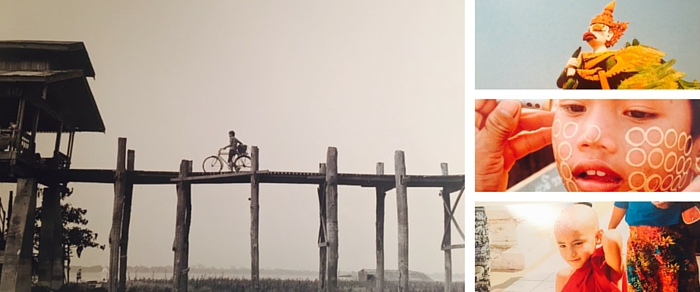 Selected images from the Myanmar photo exhibit.
Selected images from the Myanmar photo exhibit.
The UP Asian Center is hosting a photo exhibit, Myanmar Ponetwayko (Images of Myanmar), from 18 May to 30 June 2016 at the Philippines Hall, Hall of Wisdom, GT-Toyota Asian Cultural Center, Asian Center, University of the Philippines Diliman. The exhibit is free and open to the public from Mondays to Fridays, 8 am to 5 pm.
The exhibit features 40 photos taken by seven students and Prof. Rolando G. Talampas of the UP Asian Center during a study tour in Myanmar from 17 to 24 March 2016. It showcases scenes of the daily life of the peoples in the cities of Mandalay, Bagan and Yangon.
"Filipinos know so little about Myanmar," remarks Janus Isaac Nolasco, Information Officer at the UP Asian Center. "When they think of Southeast Asia, what usually comes to the mind of most Filipinos is Singapore, Bali, Kuala Lumpur, and Cambodia, especially Angkor Wat. Not Myanmar. In this sense, Myanmar is a road less traveled for Filipinos. And we hope the exhibit helps them become more aware of the country and piques their interest therein."
Myanmar is a sovereign state in mainland Southeast Asia (China to its east and the countries of south Asia to the west) of over 50 million people with over 135 distinct ethnic groups. While Myanmar is a multi-religious country, an estimate of 90% of the population practices Theravada Buddhism. The people’s devotion to the religion is demonstrated by the numerous Buddhist monks, temples and other religious sites seen throughout the country.
Since 2010,Myanmar has been negotiating a transition to democracy. The release of Nobel Peace Prize recipient Aung San Suu Kyi—known for being one of the early leaders of the democratic movement in the country—from 15 years of house arrest was regarded as one of the first steps. On November 8, 2015, elections were held for the first time in 25 years with the National League for Democracy ultimately winning by a landslide. As Myanmar re-establishes ties withthe rest of the world, it has been emerging as a captivating tourist destination.
Through this collection, the photographers hope to reveal the majestic beauty of Myanmar, its history, culture, traditions, and people. They also seek to share the Filipino students’ view of the evolving changes at the particular moment of Myanmar’s democratization and opening to the world.
The UP Asian Center offers M.A. degrees in Asian Studies with four fields of specialization: Northeast Asia, Southeast Asia, South Asia, and West Asia. The Center also has an M.A. program in Philippine Studies that allows students to major in Philippine society and culture, Philippine foreign relations, or Philippine development studies. The Center offers a Ph.D. program in Philippine Studies in conjunction with the College of Arts and Letters and the College of Social Sciences and Philosophy. Get an overview of these programs. The Asian Center also houses a peer-reviewed, open-access journal, Asian Studies: Journal of Critical Perspectives on Asia. It has published several books and monographs, and hosts or organizes various lectures and conferences.

